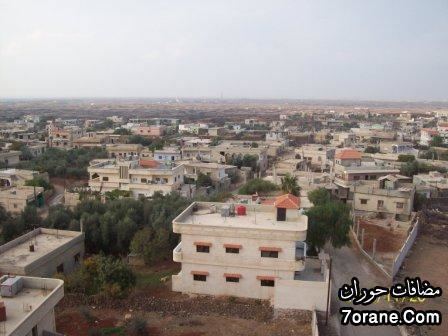Grid position 275/250 PAL | Occupation Southern Front | |
 | ||
Syrian army clashes with defectors in busra al harir
Busra al-Harir (Arabic: بصرالحرير, also spelled Busr al-Hariri, Basr al-Harir or Busra Hariri) is a town in southern Syria, part of the Daraa Governorate situated in the Hauran plain. It is located northeast of Daraa and northwest of as-Suwayda. Nearby localities include Maliha al-Atash to the southeast, al-Shaykh Maskin to the east, Izra to the northeast, Harran to the northwest, Najran to the west, al-Mazraa to the southwest and Nahitah to the south. In the 2004 census by the Central Bureau of Statistics (CBS) Busra al-Harir had a population of 13,315. Its inhabitants are predominantly Sunni Muslims.
Contents
- Syrian army clashes with defectors in busra al harir
- Map of Buser al Harir Syria
- History
- Ottoman era
- Syrian Civil War
- References
Map of Buser al Harir, Syria
History
Busra al-Harir has been identified with the Biblical city of "Bosr" where Gilead was captured by Judas Maccabeus. The town is also mentioned in the 3rd century Mosaic of Rehob. Extensive Byzantine-era ruins were found in the town. Of the ruins was a Roman temple dedicated to unspecified deity that was consecrated as a church by 517-18 CE. The temple was built by one Fl. Chrysaphios, but was consecrated by archdeacon Elias, a subordinate of bishop Varus of Zorava. A notable Christian family during this era, the Maiorinus, maintained their estates in Busra al-Harir. The family played an important role converting the inhabitants of the Lejah plain to Christianity. It is possible that tomb of Elias, is that of the prophet Elisha.
Busra al-Harir was visited by Yaqut al-Hamawi during Ayyubid rule in the 1220s. He referred to it as "Busr" and noted it was a "village of the Hauran" in the Lejah plain. Busr contained a shrine dedicated to the prophet Joshua (Arabic: "Nabi Yusha") and the tomb of Sheikh al-Hurairi. According to al-Harawi, the tomb of Ilyas ("Elias") was revered in Busra al-Harir.
Ottoman era
During early Ottoman Empire rule, Busra al-Harir was a large village. In 1596 it appeared in the Ottoman tax registers as Busr and was part of the nahiya of Badi Sarma in the Qada of Hauran. At that time it had an all Muslim population of 42 households and 31 bachelors, who paid taxes on wheat, barley, summer crops, goats and/or beehives.
Towards the end of Ottoman rule in Syria, the residents of Busra al-Harir engaged in regular clashes with the residents of Jabal al-Druze. In 1879 fighting flared up between the townspeople and the Druze after the Muslim inhabitants of several nearby villages fled to Busra al-Harir as a result of fighting between the al-Atrash family, a leading Druze clan, and the local Bedouin. With pressure from the Ottoman government in Damascus, a truce was reached that year stipulating a Druze evacuation of Muslim villages in the Hauran occupied during the previous years.
By 1885 the Ottoman government set up Busra al-Harir as one of 42 stations on the telegraph grid which extended from Aleppo in the north to Gaza in the south. In 1892 Osman Nuri Pasha, the Ottoman governor of Damascus, demanded the completion of land registration in Busra al-Harir in attempt to extend central government control over the outlier Hauran and Transjordan regions. The town's inhabitants resisted the measure, leading to a shootout which resulted in the wounding of the district governor.
In May 1909 a dispute between the chief of Jabal al-Druze, Yahya "Bey" Atrash, and his business partner in a steam mill in Busra al-Harir led to armed clashes between the Druze and the town's residents. The latter were supported by the Ottoman government which prepared a large army headed by Sami Pasha Faruqi to put down the Druze revolt in August 1910. Busra al-Harir was one of the principal garrison towns from which the Ottoman army launched its campaign. Atrash's forces were decisively defeated with an estimated 2,000 Druze killed and hundreds of fighters imprisoned. Consequently, the Ottoman government successfully began the process of extending direct rule to the Hauran.
Syrian Civil War
Busra al-Harir has reportedly been a stronghold for the opposition Free Syrian Army (FSA) during the 2011-2012 Syrian uprising against the government of Bashar al-Assad. From the town and the nearby Laja area, the FSA have attacked military supply lines.
Two residents were reported killed by security forces on 10 June 2011, according to the opposition. State television reported a policeman was shot dead in the town on 16 September. On 11 December, the Syrian Army's Izra'-based 12th Armoured Brigade stormed the town in an attempt to rout out FSA fighters.
According to opposition activists, two people were killed and dozens were injured after Busra al-Harir was shelled by Syrian Army tanks in April 2012.
A free-lance journalist for Al Jazeera and opposition activist, Mohammad al-Massalma ("al-Horani"), was killed by sniper in Busra al-Harir by security forces, according to activists.
In early February 2013, a viral video emerged in YouTube showing Syrian Army soldiers in Busra al-Harir dancing to the American R&B singer Usher hit Yeah! in a pause on the battlefield. The video ended with the soldiers chanting "With our souls, our blood, we sacrifice for you Bashar!" and firing their weapons to the air.
In late August 2014, the rebel battalions targeted the government-held areas in the city, while army units targeted rebel vehicles.
